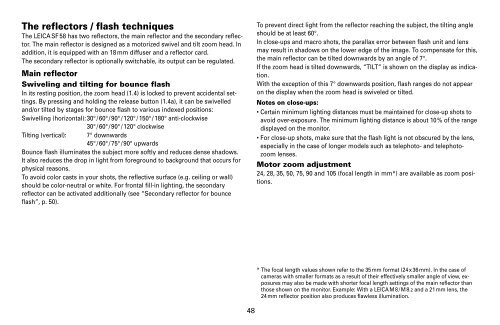Create successful ePaper yourself
Turn your PDF publications into a flip-book with our unique Google optimized e-Paper software.
The reflectors / flash techniques<br />
The LEICA <strong>SF</strong> <strong>58</strong> has two reflectors, the main reflector and the secondary reflector.<br />
The main reflector is designed as a motorized swivel and tilt zoom head. In<br />
addition, it is equipped with an 18 mm diffuser and a reflector card.<br />
The secondary reflector is optionally switchable, its output can be regulated.<br />
Main reflector<br />
Swiveling and tilting for bounce flash<br />
In its resting position, the zoom head (1.4) is locked to prevent accidental settings.<br />
By pressing and holding the release button (1.4a), it can be swivelled<br />
and/or tilted by stages for bounce flash to various indexed positions:<br />
Swivelling (horizontal):30° / 60° / 90° / 120° / 150° / 180° anti-clockwise<br />
30° / 60° / 90° / 120° clockwise<br />
Tilting (vertical): 7° downwards<br />
45° / 60° / 75° / 90° upwards<br />
Bounce flash illuminates the subject more softly and reduces dense shadows.<br />
It also reduces the drop in light from foreground to background that occurs for<br />
physical reasons.<br />
To avoid color casts in your shots, the reflective surface (e.g. ceiling or wall)<br />
should be color-neutral or white. For frontal fill-in lighting, the secondary<br />
reflector can be activated additionally (see “Secondary reflector for bounce<br />
flash”, p. 50).<br />
48<br />
To prevent direct light from the reflector reaching the subject, the tilting angle<br />
should be at least 60°.<br />
In close-ups and macro shots, the parallax error between flash unit and lens<br />
may result in shadows on the lower edge of the image. To compensate for this,<br />
the main reflector can be tilted downwards by an angle of 7°.<br />
If the zoom head is tilted downwards, “TILT” is shown on the display as indication.<br />
With the exception of this 7° downwards position, flash ranges do not appear<br />
on the display when the zoom head is swiveled or tilted.<br />
Notes on close-ups:<br />
• Certain minimum lighting distances must be maintained for close-up shots to<br />
avoid over-exposure. The minimum lighting distance is about 10 % of the range<br />
displayed on the monitor.<br />
• For close-up shots, make sure that the flash light is not obscured by the lens,<br />
especially in the case of longer models such as telephoto- and telephotozoom<br />
lenses.<br />
Motor zoom adjustment<br />
24, 28, 35, 50, 75, 90 and 105 (focal length in mm*) are available as zoom positions.<br />
* The focal length values shown refer to the 35 mm format (24 x 36 mm). In the case of<br />
cameras with smaller formats as a result of their effectively smaller angle of view, exposures<br />
may also be made with shorter focal length settings of the main reflector than<br />
those shown on the monitor. Example: With a LEICA M 8 / M 8.2 and a 21 mm lens, the<br />
24 mm reflector position also produces flawless illumination.


